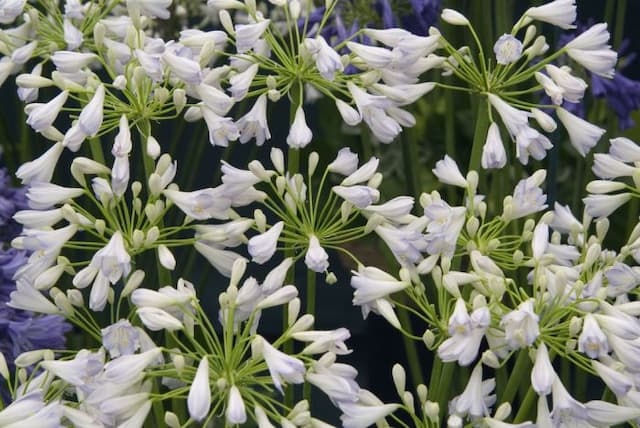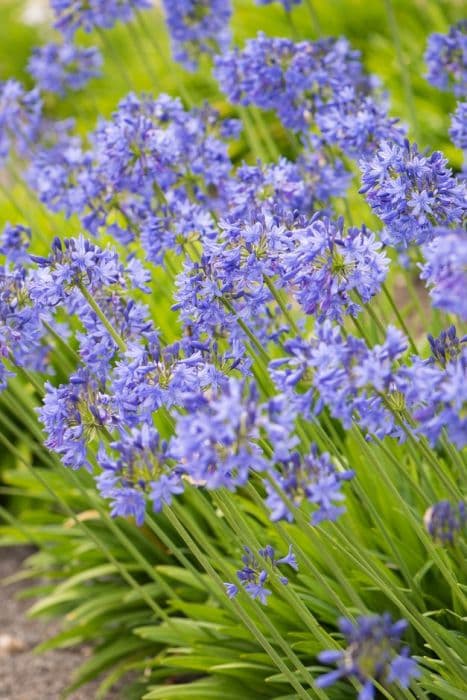Lily of the Nile Agapanthus 'Johanna'

ABOUT
Agapanthus 'Johanna' is a perennial plant known for its striking display of flowers. This plant features a clump of strap-shaped, glossy, dark green leaves that gracefully arch outwards. It is the beautiful globes of funnel-shaped flowers that truly set it apart. These flowers appear on stiff, upright stalks that rise above the foliage, forming a canopy of color. The blossoms are typically a deep blue or purple, although some variants may have white or lighter blue flowers. Each flower cluster is packed with numerous individual blooms that open progressively, providing a prolonged display of vibrant blooms. The overall impression of Agapanthus 'Johanna' is one of elegance and dramatic flair, making it a popular choice for ornamental gardens.
About this plant
 Names
NamesSynonyms
African Lily, Lily of the Nile, Love Flower
Common names
Agapanthus 'Johanna'
 Toxicity
ToxicityTo humans
The Agapanthus, commonly known as African Lily or Lily of the Nile, contains mildly toxic compounds that can cause gastrointestinal issues if ingested. Symptoms of African Lily poisoning may include nausea, vomiting, and diarrhea. Contact with the sap can potentially cause skin irritation or allergic reactions in some individuals.
To pets
African Lily is toxic to dogs, cats, and horses. If a pet ingests parts of the African Lily, it can cause symptoms such as vomiting, diarrhea, abdominal pain, and sometimes excessive salivation. It is crucial to prevent pets from chewing or ingesting any part of the plant and to seek veterinary attention if they do.
 Characteristics
CharacteristicsLife cycle
Perennials
Foliage type
Evergreen
Color of leaves
Green
Flower color
Blue
Height
2 feet [60 cm]
Spread
2 feet [60 cm]
Plant type
Bulb
Hardiness zones
8
Native area
South Africa
Benefits
 General Benefits
General Benefits- Ornamental Appeal: The Agapanthus 'Johanna', commonly known as the African Lily, features striking blue or purple flowers that add color and aesthetic appeal to gardens and landscapes.
- Drought Tolerance: African Lilies are relatively drought-tolerant once established, making them suitable for water-wise gardening.
- Low Maintenance: They require minimal care beyond the occasional watering and fertilizing, making them a hassle-free choice for busy gardeners.
- Attracts Pollinators: The showy blooms of the African Lily are attractive to bees, butterflies, and other pollinators, which are vital for the health of the ecosystem.
- Long Blooming Period: African Lilies have a long flowering period that usually spans the summer months, providing long-term visual interest in the garden.
- Versatile Planting: They can be planted in beds, borders, and containers, offering flexibility in landscape design and use of space.
- Cut Flowers: The long stems and beautiful blooms of the African Lily make excellent cut flowers for arrangements and bouquets.
 Medical Properties
Medical PropertiesThis plant is not used for medical purposes.
 Air-purifying Qualities
Air-purifying QualitiesThis plant is not specifically known for air purifying qualities.
 Other Uses
Other Uses- Accent in floral arrangements: Agapanthus flowers have long stems and bold blooms, making them a popular choice to add height and architectural interest in cut flower arrangements.
- Poolside landscaping: Given its tall structure and clump-forming habit, Agapanthus is commonly used to create a lush backdrop around pools, adding a touch of tropical ambiance.
- Erosion control: With its dense root system, Agapanthus can be utilized on slopes or areas prone to erosion to help stabilize the soil.
- Edging for pathways: Smaller varieties of Agapanthus, when planted in a row, serve as a neat, low-maintenance border along garden paths.
- Coastal gardens: Agapanthus is notably salt-tolerant, making it suitable for gardens in coastal areas where salty air can impact other less tolerable plants.
- Creative writing inspiration: The striking appearance of the Agapanthus has been mentioned in poetry and prose, making it a source of inspiration for creative writers.
- Patio container planting: Due to its neatly clumping growth habit and showy flowers, Agapanthus works well in large pots for a statement ornamental feature on patios or balconies.
- Theme gardens: Agapanthus can be included in African-themed gardens since it's native to South Africa, thus contributing to a region-specific landscape design.
- Water-wise gardening: As a drought-tolerant plant once established, Agapanthus is ideal for xeriscaping, which aims to reduce the need for supplemental watering.
- Teaching tool: Agapanthus can serve as an educational specimen for botany students learning about monocot plants, as Agapanthus is a traditional example used to illustrate this group.
Interesting Facts
 Feng Shui
Feng ShuiThe African Lily is not used in Feng Shui practice.
 Zodiac Sign Compitability
Zodiac Sign CompitabilityThe African Lily is not used in astrology practice.
 Plant Symbolism
Plant Symbolism- Love: Deriving from the Greek words 'agape' meaning love, and 'anthos' meaning flower, Agapanthus is often associated with the love of two people.
- Beauty: With its striking blue to purple flowers, Agapanthus symbolizes beauty and a sense of wonder in the natural world.
- Fertility: This plant is frequently connected to fertility because of its lush, full blooms and rapidly multiplying nature.
- Endurance: Agapanthus is known to be a hardy plant, able to withstand various conditions, symbolizing resilience and durability.
 Water
WaterLily of the Nile should be watered deeply once a week, providing about one inch of water each time. The soil should be allowed to dry out between waterings to avoid root rot. During the growing season in spring and summer, you may need to water more frequently due to higher temperatures. In winter, reduce watering as the plant goes dormant. It is important to avoid water logging, so ensure good drainage in the pot or planting area.
 Light
LightLily of the Nile thrives in full sun to partial shade. The ideal spot for this plant is where it can receive at least six hours of sunlight per day. However, if you live in a particularly hot climate, providing afternoon shade can help protect the plant from intense heat.
 Temperature
TemperatureLily of the Nile prefers temperate climates and can tolerate temperatures as low as 20 to 25 degrees Fahrenheit, but should be protected from frost. The ideal temperature range for this plant is between 70 and 90 degrees Fahrenheit during the growing season. They may go dormant in temperatures outside this range.
 Pruning
PruningLily of the Nile should be pruned to remove spent flower stalks and to tidy up any dead or damaged leaves. This is typically done after flowering in late summer or fall. Regular pruning encourages new growth and more abundant blooms the following season.
 Cleaning
CleaningAs needed
 Soil
SoilFor Lily of the Nile, a well-draining soil mix with compost and perlite is ideal. Maintain a soil pH between 6.0 and 8.0.
 Repotting
RepottingLily of the Nile should be repotted every 2 to 3 years or when it becomes root-bound.
 Humidity & Misting
Humidity & MistingLily of the Nile prefers moderate humidity levels but is quite adaptable to varying household conditions.
 Suitable locations
Suitable locationsIndoor
Ensure bright light, well-draining soil, and moderate watering for Lily of the Nile.
Outdoor
For Lily of the Nile, choose a sunny spot with fertile, well-drained soil.
Hardiness zone
8-10 USDA
 Life cycle
Life cycleAgapanthus 'Johanna', commonly known as Lily of the Nile, begins its life cycle with seed germination, which occurs in warm, moist soil conditions. The seeds develop into small seedlings with initial leaves and a root system. As the plant matures, it forms a clump of strap-like leaves and establishes a robust root network. Vegetative growth continues with the leaves elongating, and the plant eventually produces tall flower stalks topped with rounded clusters of blue or purple flowers in summer. After flowering, seed pods may form, which burst open when dry, releasing seeds that can propagate new plants. Finally, Agapanthus 'Johanna' may enter a period of dormancy during colder months, especially in cooler climates, before resuming growth when the conditions become favorable again.
 Propogation
PropogationPropogation time
Spring-Early Summer
Propogation: Agapanthus 'Johanna', commonly known as Lily of the Nile, is most effectively propagated through division, which should take place after the flowering season has ended, usually during the fall. To propagate by division, carefully lift the clump out of the ground with a shovel and gently separate the rhizomes, ensuring that each division has at least one fan of leaves and a portion of roots. Replant the divisions immediately, maintaining the same planting depth as before, which typically means the crown should be about 1-2 inches (2.5-5 cm) below the surface. Water the newly planted divisions thoroughly to help establish them. This method of division allows for the rapid increase of plants and is often preferred for its simplicity and effectiveness.









